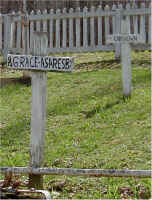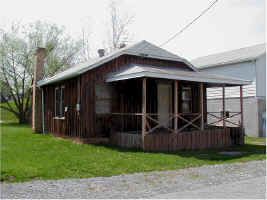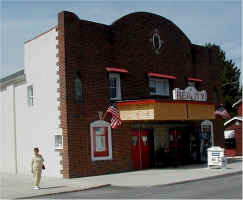In April, 2004, Aunt Angie and I (Uncle Angelo Coniglio) visited Robertsdale, in Huntingdon County, Pennsylvania. We toured
the
Broad Top Area Coal Miners Museum and the Italian Cemetery, and
spoke with Research Librarian Carolyn Carroll and staff members Margaret Duvall and Dennis Fields;
with John Ciampa, a director of the Broad
Top Area Coal Miners Historical Society;
and with Bill Rourke and Jim
Territo, long-time residents of Robertsdale.
The material below was derived from our
conversations with them, from news articles posted at the museum, and from books written
by
Ron Morgan, a Robertsdale native and conservationist. All of them were very
helpful, and their fierce pride in Robertsdale's history is evident. I also
spoke on my return with Russell Asarese, born in Robertsdale in 1914, and a Buffalonian since
1926.
[Briefly, as stated on the Robertsdale page, Giuseppe
Coniglio came in 1912 and
was joined in 1913 by his wife Angela
Alessi Coniglio, accompanied
by his brother Gaetano
Vincenzo Coniglio. Gaetano's wife (and Angela's sister) Rosa Alessi Coniglio and their son Gaetano Vincenzo (Guy
Vincent) joined him there in
December 1914. For a time, Gaetano also lived and worked in Pittston, in eastern Pennsylvania.]
Unlike many inexperienced immigrants,
Giuseppe, Gaetano, and
their countrymen (paesane) from Serradifalco were seasoned miners. They
were hired by the Rockhill Iron and
Coal Company to mine bituminous
or "soft" coal from deep mines near Robertsdale. The miners were
virtually "owned" by the company, and about the only place they could
spend their wages was at the company
store. They were required to provide
their own tools (sometimes home-made to save money), and even to buy their own blasting
powder (from the company store). They were paid not by the ton, but by the
"yard", that is, the depth of the coal they excavated from the mine wall each
day.
The homes were built and owned by the company,
and much of the miner's pay went towards renting them. In the January 1920 Census,
Gaetano (listed
as "Guy") and Rosa (listed as "Rosy"), their last name
mis-spelled as "Comellia", were shown as renters of 100 Spring Street, Robertsdale. Listed as their children were Guy, age 6; Leonardo, age 4 years and 2 weeks; and Raimondo, age 3. Felice was born in December, after the census was taken.
The Coniglios' neighbors, at 96 Spring Street, were Calogero and Grace Asarese Butera,
also from Serradifalco. Grace was the granddaughter of another Grace Asarese, who
has one of the few marked graves in the Italian
Cemetery (photo below). The grave was
frequently visited by her grandson Russell Asarese (Grace Asarese Butera's brother) of
Buffalo. The other photo below shows an existing house on Spring Street, believed to
be the last home remaining from the 1920s.
There was no electricity, and the streets were dirt, covered in cinders. There was
no running water: the women and children carried water for cooking and laundry, from a
natural spring at the end of Spring Street. The town had a public school which Guy Jr. may
have attended, but the Catholic church was not built until 1922, next to the
Italian Cemetery. Before the church was built, a visiting
priest would hold masses, christenings, and marriages in available buildings. In
1918, the town's movie house, the Liberty
Theatre, was built on Main
street. The theatre burned down in 1936. In 1948 it was rebuilt and re-opened
as the Reality Theatre, and the building (photo below) is now the home of the Broad Top Area Coal Miners Museum.
The three boys born in Robertsdale were baptized
from the Immaculate Conception Church, in Dudley, Pensylvania, four
miles away; either in the church itself or by a travelling priest from that
church. See the pages of
Leonard,
Ray, and
Felice for their baptism records.
Robertsdale also had an
"Italian
Band" which was renowned in the area, and the focus of attention
at Italian gatherings, especially every Columbus day, which the miners wanted as a holiday
from work. [See photo below]
The men were strong union men and
good workers
who on a normal day did not see the light of day: they entered the mines before dawn and
returned after dark. This led to several strikes for better working conditions,
including one in 1916 and another in 1922. While the men were in the mines, the
wives fetched water, took care of the homes and children, and sometimes did laundry or
house-cleaning or took in boarders for extra income. And they prayed that their men
would come home safely. The immigrants came from a small, remote mountain town in
Sicily to a small, remote mountain town in Pennsylvania. In an already isolated
town, they were further isolated by their ethnicity: even other "Italians"
in the town (immigrants from mainland Italy; Rome, Naples, etc.) were slow to accept the "Sicilian
peasants".
The company intentionally grouped the miners'
living quarters by nationality. Poles and Slavic miners were on the West side of
town; Welsh, Irish and German in the middle; some Sicilians were in Woodvale, about a mile
away; and Italians and Sicilians were housed on the East side of Robertsdale on Spring
Street and Wood Street. The Italian/Sicilian sections were often referred to as
"Africa" by others.
The bias against the Sicilians had
repercussions. Two young Sicilian boys, the Latone (Latona) brothers, were
continually taunted by a local bully, Perry Everhardt. The younger Latona brother
had the chore of carrying water to his home each day. One morning Everhardt
tripped him, spilling the water. The boy went into his house, got his father's
shotgun, and shot and killed Everhardt. There are conflicting reports as to whether
he was ever punished. Some say that shortly after the shooting, five families of
Sicilians were evicted from Woodvale and moved to the East side of Robertsdale.
The 1922 strike may have been the final reason
Gaetano and his family left Robertsdale, but their leaving was likely spurred by a
number of factors: reported "lawlessness" among the Sicilians; fights
and shootings over card games or wine sales; the influenza epidemic of 1918, which claimed
a number of Sicilian victims (possibly including Angela Alessi Coniglio); the
"petering out" and eventual closing of some mines in the mid-twenties; and the
"black lung" disease, which many workers were beginning to contract, after ten
years in the mines.
Today, there are few Italian families in
Robertsdale. The local Pennsylvania dialect has modified even their names to suit the
community. Ciampa becomes "Sy-ampa", Marcocci is reduced to "Marcoss", and Rossi to "Ross".
The only remnant that we found of the Serradifalco Sicilians was
Vincenzo (Jim) Territo
(known locally as 'Jimmy Treat'), one of a local family of barbers whose father Calogero immigrated from
Serradifalco in 1903. Calogero was the grandson of another Calogero
Territo, who was born in Serradifalco in about 1804. That earlier
Calogero married my "half-GGG-aunt Gaetana Marino.
Jim Territo's father
Calogero was an illiterate miner, but as Jim described
it, "Somehow, my father found the Land Office in Pittsburgh and managed to buy
four acres of ground that wasn't owned by the mine company."
That
Calogero
Territo became
a land owner and businessman, even opening a store to compete with the "company
store". In doing so, he managed to do something the other Sicilians were
unable to do: establish roots in the community. My research of
Serradifalco roots some time after we met 'Jimmy Treat' found that my GGGG-grandmother
Crocifissa Papia re-married after
my GGGG-grandfather Pietro Lattuca died, and she and her second
husband Leonardo Marino had a daughter who married a Territo, and
were ancestors of Jimmy Treat. So Jimmy is my 'half-third cousin,
twice removed'!
I don't know if the following conversation
actually took place, but I can just hear
Rosa saying to Gaetano: "Li
Americani ni dispiacianu pirchi simmu 'Taliani. Li 'Taliani ni dispacianu pirchi
dicianu ca nun simmu Italiani. A Pittistoni, unn ti piaceru pirchi a
lavuratu cu lu carbuni "leggia" anzi di carbuni "duru".
La mia suru si ni ji a Sicilia. Lu maritu di la mia amica havi lu pulmuni
niru". Ora, c'e 'nu scioperu, e li pazzi ca bruscianu li casi
nustri. 'Ammunini di 'stu pustu!" ['The Americans dislike us because we're
Italian. The Italians dislike us because they say we're not Italian. In
Pittston, they even disliked you because you were a "soft" coal miner, not a
"hard" coal miner. My sister has gone back to Sicily. My friend's husband
has the "black lung". Now, there's a strike, and the
crazy ones who burn our houses. Let's go from
this place!']
After the
turbulence of the early 1920s, the Coniglio family and most, if not all of the other
Serradifalchese, walked to the train depot and boarded a narrow-gage East Broad Top Railroad train to Mount Union, whence they took a standard-gage train to points
north and Buffalo. Why they chose Buffalo, and whether they left en masse or in
dribs and drabs, we don't know (yet). Gaetano's naturalization papers
include affidavits by two friends from Robertsdale, Salvatore Latona and
Salvatore Giordano, who stated that the Coniglio family left Robertsdale
"in early 1921". Felice
(Phil) was born in Robertsdale in December, 1920, and Carmela
(Millie) was born in
Buffalo
in May, 1923. |




